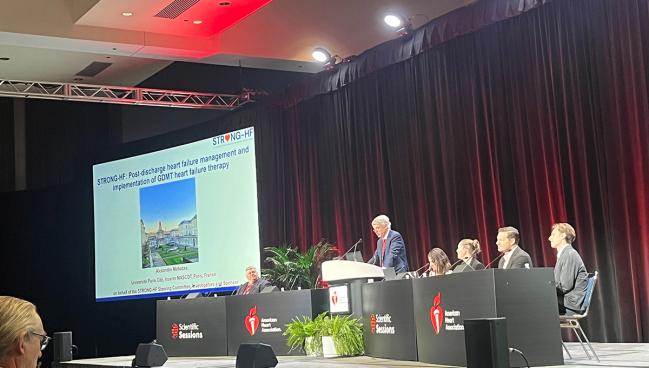STRONG-HF: Rapid Uptitration of GDMT After Acute HF Pays Dividends
This “further motivates us to find systems of care that optimize medical therapy in this vulnerable period,” Amanda Vest says.

CHICAGO, IL—Getting patients up to full doses of guideline-recommended medications within just 2 weeks of an acute heart failure (HF) hospitalization improves measures of congestion and clinical outcomes, the STRONG-HF trial shows.
Compared with usual care, rapid uptitration of renin-angiotensin-system (RAS) blockers, beta-blockers, and mineralocorticoid receptor antagonists (MRAs)—under close supervision across multiple postdischarge visits—lowered the rate of all-cause death or HF readmission at 180 days (15.2% vs 23.3%; P = 0.021), according to Alexandre Mebazaa, MD, PhD (Université Paris Cité, INSERM MASCOT, Paris, France).
Patients who received high-intensity management also had better quality of life, he reported here at the American Heart Association 2022 Scientific Sessions.
Patients will love these results, published simultaneously online in the Lancet, “because for the first time we’re going to tell them, ‘If you take full-dose medications, you will have an immediate positive effect,’” Mebazaa said at a press conference.
And for clinicians, who may be concerned about potential adverse effects associated with ramping up doses of multiple medications all at once, he added, “we are telling them it’s safe.” Although overall adverse events were more frequent in the high-intensity group, likely related to the greater number of clinic visits, Mebazaa noted, there were similar rates of serious and fatal events.
Commenting for TCTMD, Amanda Vest, MBBS (Tufts Medical Center, Boston, MA), said “the trial offers additional encouragement and further motivates us to find systems of care that optimize medical therapy in this vulnerable period after a hospitalization.”
STRONG-HF also “expands our thinking in terms of how we deliver this intensive level of care” and how various members of the care team, including physicians, pharmacists, nurses, and advanced practice providers, should be involved. “It really inspires us to think further about how we best utilize our inpatient and outpatient multidisciplinary teams to deliver an intensity of care that more meets the intensive arm in this study and goes beyond what we’re doing in some of our standard of care.”
The STRONG-HF Trial
Mebazaa highlighted the scope of the problem STRONG-HF was designed to address by pointing out that there are more than 10 million hospitalizations for acute HF around the world each year. Few of those patients, however, are monitored or treated with full doses of guideline-directed medical therapy (GDMT).
The latest heart failure guidelines from Europe and the United States recommend an early follow-up visit 1 to 4 weeks after discharge following an acute HF episode, but that guidance is based on a low level of evidence, Mebazaa said.
STRONG-HF, an open-label trial conducted across 87 centers in 14 countries, helps bolster the data in that area. Investigators enrolled patients hospitalized with acute HF who were set to be discharged, were not being treated with full doses of GDMT, and had NT-proBNP levels greater than 1,500 pg/mL. Patients were randomized to usual care or high-intensity management focused on uptitrating three classes of medications:
- ACE inhibitors/ARBs/angiotensin receptor-neprilysin inhibitors (ARNIs)
- Beta-blockers
- MRAs
Patients assigned to the intervention were started on those three classes of drugs at half the recommended doses before they were discharged from the hospital. The first postdischarge visit at 1 week focused on an assessment of safety based on a clinical exam and laboratory tests. The second visit at 2 weeks involved uptitration to full doses of the recommended medications, along with a safety assessment. At weeks 3 and 6, there were additional visits to assess clinical status and safety.
At the time the trial was running, sodium-glucose cotransporter 2 (SGLT2) inhibitors were either not approved in heart failure or were not widely used, the authors note in their paper.
The trial was stopped early due to a greater-than-expected benefit of high-intensity therapy after 1,078 patients (mean age 63 years; 39% women) were randomized. Patients across the spectrum of LVEF were included, with about two-thirds having an ejection fraction of 40% or less.
By day 90, the intervention resulted in higher proportions of patients being on full doses of the prescribed drugs, which was consistent for RAS blockers (55% vs 2%), beta-blockers (49% vs 4%), and MRAs (84% vs 46%). The differences were maintained at 180 days.
That impact translated into significant improvements in multiple measures of congestion by day 90, including jugular venous pressure, respiratory rate, peripheral edema, NYHA class, body weight, and NT-proBNP concentrations, and also a lower rate of HF readmission or all-cause death at 180 days (adjusted absolute risk difference of 8.1%).
Moreover, the change from baseline to day 90 in quality of life—as assessed using the EQ-5D visual analog scale—was greater in the high-intensity group (10.72 vs 7.22 points; P < 0.0001).
The overall adverse event rate at 90 days was higher in the intervention arm of the trial (41.1% vs 29.5%), but rates were similar in the two arms for serious events (16.2% vs 17.2%) and fatal events (4.6% vs 6.0%).
More Implementation Work Needed
These encouraging results build on what had been hinted at in prior heart failure studies—that initiation of GDMT either in the hospital or shortly thereafter improves outcomes, Vest said.
It was disheartening to see that even in the high-intensity arm, the proportion of patients on full doses of RAS inhibitors and beta-blockers was not closer to 100%, she commented. “But I think it just underscores the difficulty of uptitrating these medications for patients with heart failure, especially in that vulnerable period postdischarge, and underscores the importance of not only the regular check-ins that were part of the intensive-care arm here but also the skill and expertise of the care team in achieving uptitration.”
Implementing this type of approach, with multiple clinic visits in the first 90 days after discharge, has resource implications, but HF rehospitalizations represent a heavy burden on the healthcare system, too, Vest said. “So it’s going to be very helpful as both healthcare systems and payers consider how we best take care of patients and do it in the most cost-effective way to use this data to weigh up the opportunities provided by very intensive early follow-up after hospitalization,” she said.
A critical piece that is still lacking when it comes to implementation, commented Clyde Yancy, MD (Northwestern Medicine, Chicago, IL), is how this type of strategy for rapid uptitration affects both adverse effects and adherence to medications over the longer term.
“Starting all the therapies at once, does that enable adherence? That might. Or does that lead to a greater retreat from indicated therapies?” Yancy said, noting that patients worry about taking so many medications and might also stop taking them once they start to feel better. “I think the point of emphasis is to be encouraged about new data helping us understand implementation, but to also be somewhat circumspect because we need much more.”
Rather than focusing on the impacts of these drugs on morbidity and mortality, which have already been established, implementation studies should zero in on whether these types of efforts improve outcomes faster and better (with improved adherence), as well as safely, he said. “We have to totally rethink how we approach implementation.”
Research like this also raises intriguing questions about the possibility of putting these drugs together in a polypill, Yancy said. “If nothing else, the data do demonstrate that when exposed to all therapies over a short period of time, at least the first expression of the data would suggest that patients can tolerate those multiple vasoactive therapies,” he said. “That would tell me then that if we found a different way to give those therapies, as in a polypill, we should be able to expect the same sort of tolerability.”
Development of a polypill is “the kind of breakthrough we need to really get to the next tier. But again, this is an encouraging step,” Yancy said, adding that it’s important to remain circumspect for the time being “because of a number of questions that we still need to pursue.”
Todd Neale is the Associate News Editor for TCTMD and a Senior Medical Journalist. He got his start in journalism at …
Read Full BioSources
Mebazaa A, Davison B, Chioncel O, et al. Safety, tolerability, and efficacy of up-titration of guideline-directed medical therapies for acute heart failure (STRONG-HF): a multinational, open-label, randomised trial. Lancet. 2022;Epub ahead of print.
Disclosures
- STRONG-HF was funded by through a grant provided to the Heart Initiative by Roche Diagnostics International.
- Mebazaa reports having received grants from Roche Diagnostics, Abbott Laboratories, 4TEEN4, and Windtree Therapeutics and honoraria for lectures from Roche Diagnostics, Bayer, and MSD; being a consultant for Corteria Pharmaceuticals, S-form Pharma, FIRE-1, Implicity, 4TEEN4, and Adrenomed; and being coinventor of a patent on combination therapy for patients having acute or persistent dyspnea.





Comments